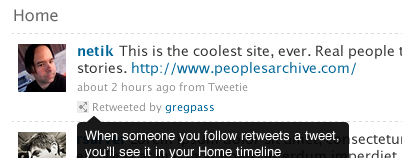Retweet Changes and Twitter Plagiarism

Though Twitter plagiarism has never raised the copyright questions that come with blog plagiarism, it certainly has caused some emotional outbursts. For some time now a safe way to start a fight among Twitter users has been to ask about best practices when retweeting. Though everyone seems to agree that attribution is necessary, how to provide it has been a tricky matter.
Some provide it at the beginning of the tweet (RT @username TWEET), others at the end (TWEET via @username) but other than the RT as the standard abbrevation for “Retweet”, not much has become consistent.
This becomes worse when a tweet is too long to retweet properly, meaning the original tweet plus the attribution is too long to send out. This forces a devil’s choice of either changing the original tweet, thus possibly changing the meaning on accident, or lobbing off attribution.
Help may be on the way though, yesterday, Twitter announced that they were making changes to both their user interface and their API to make retweeting easier and more consistent.
This could finally put an end to the problems with retweeting and help separate the malicious plagiarists from those who simply haven’t learned how to RT properly.
Retweet Changes
The basic idea of the new change is that, instead of the retweet appearing to be from the person doing the retweeting, it will instead appear to be a tweet from the original author, with a line below it (similar to the “in reply to” line that exists now) indicating who sent out the retweet. See draft mockup below:

For example, if I retweet something by my co-host @ifroggy (Patrick O’Keefe), even if you do not follow his account, you’ll see his icon and the original tweet appear in your timeline. Underneath the tweet will be a short line indicating that it was retweeted by me.
This ensures that the content of the tweet will be easily identified as being from Patrick and will introduce him to the my followers in a much better way than a simple @mention in a retweet. The solution also makes it much cleaner for people to retweet other’s retweets, avoiding the “RT @username RT @username” kludge that has existed for some time.
Developers should be able to work this into their existing Twitter applications and the changes should be available to all users some time within the next few weeks.
Tweet This
The new system, if it goes through as planned, will solve nearly all existing problems with retweeting. Tweets can’t be too long to retweet since the original one is used, there’s no need to argue over how to properly attribute a tweet as there will now be a formal system in place and it makes it easier to spot the spammers and other abusers as those who don’t use the system to retweet other’s work will likely have more selfish intentions than simply be ignorant of the rules.
However, the system isn’t without its detractors. Commenters to a recent post on the changes in TechCrunch expressed concern that they won’t be able to edit the Retweets they send out, making it impossible for them to add their own element to them.
Indeed, the process does appear to be fairly automatic. Once you click the link to send the retweet and confirm you want to send it, the tweet goes out without any opportunity to edit. However, this also solves the problem of fake retweets being sent out using celebrities names, which became a major problem for a while in July.
The question is whether it is worth the ability to edit retweets for the standardized system, better exposure to the original author and convenience of the impending new system.
The answer to that will likely depend upon one’s own Twitter habits.
Bottom line
The new system will hopefully clear up and fix a lot of the problems with retweets that have been plaguing Twitter. It’s easier to use, provides better attribution and creates a good standard for use. However, it clearly doesn’t fit all cases or all uses of the existing RT system.
As such, it seems likely that the existing methods for retweeting will hang around, at least for limited use, and that new standards will be developed by the community that will address those limited cases.
However, if those standards are anything like existing ones, they won’t be very consistent and may lead to some inadvertent strife. Still, a partial solution that covers most retweet cases is still better than no solution at all.
Want to Reuse or Republish this Content?
If you want to feature this article in your site, classroom or elsewhere, just let us know! We usually grant permission within 24 hours.
